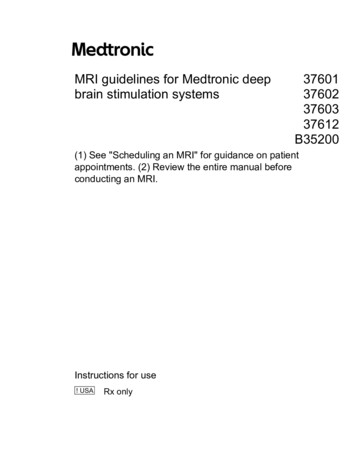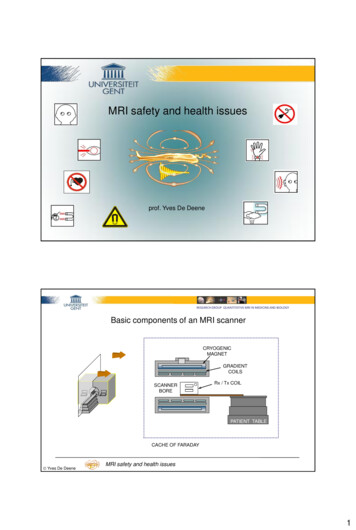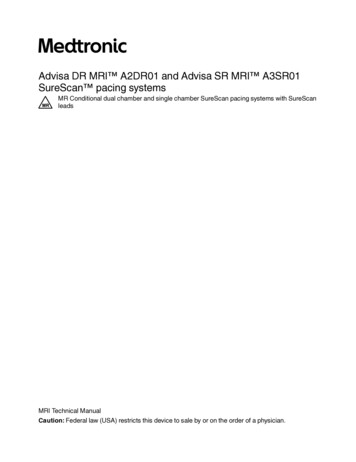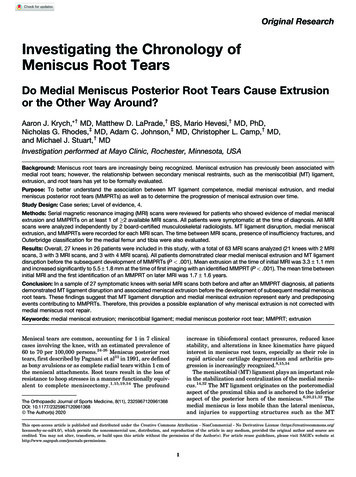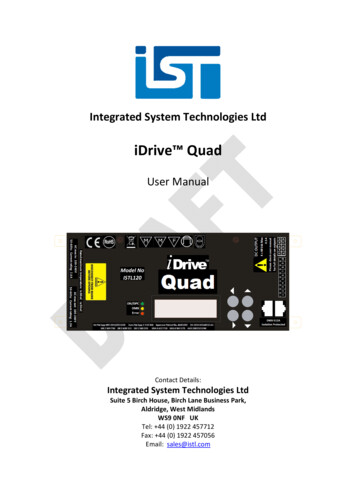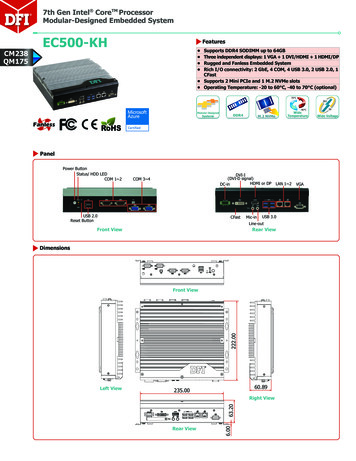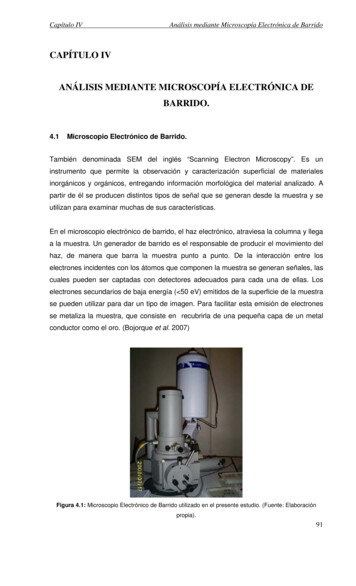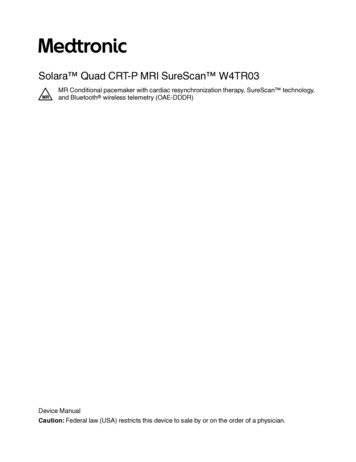
Transcription
Solara Quad CRT-P MRI SureScan W4TR03MR Conditional pacemaker with cardiac resynchronization therapy, SureScan technology,and Bluetooth wireless telemetry (OAE-DDDR)Device ManualCaution: Federal law (USA) restricts this device to sale by or on the order of a physician.
The following list includes trademarks or registered trademarks of Medtronic in the United States andpossibly in other countries. All other trademarks are the property of their respective owners.Advisa, Advisa DR MRI, Capture Management, Cardiac Compass, CardioSync, CareAlert, CareLink,EnPulse, EnRhythm, EnRhythm MRI, Flashback, GEM, GEM III, InSync, InSync II Marquis,InSync III Marquis, InSync Marquis, Kappa, Marquis, Medtronic, Medtronic AT500, Medtronic CareAlert,Medtronic CareLink, MVP, OptiVol, Quick Look, Reactive ATP, Revo MRI, Solara, SureScan,TherapyGuide, VectorExpress
Contents1 System overview 41.11.21.31.41.51.61.7Introduction 4System description 4Indications and usage 5Contraindications 5MRI conditions for use 6Feature summary 7Data security 92 Warnings, precautions, and potential adverse events 102.12.22.32.42.52.6General warnings and precautions 10Explant and disposal 10Handling and storage instructions 10Lead evaluation and lead connection 11Device operation 11Potential adverse events 133 Clinical data 143.1Adverse events and clinical trial data 144 Implant procedure 164.14.24.34.44.54.64.7Preparing for an implant 16Selecting and implanting the leads 18Testing the lead system 19Connecting the leads to the device 19Positioning and securing the device 21Completing the implant procedure 22Replacing a device 225 Product specifications 235.15.25.35.4Physical characteristics 23Electrical specifications 25Replacement indicators 26Projected service life 276 Device parameters 286.16.26.36.46.56.66.76.86.96.10Emergency settings 28Magnet application 29Tachyarrhythmia detection parameters 29Atrial tachyarrhythmia therapy parameters 30Pacing parameters 32Data collection parameters 37Medtronic CareAlert parameters 38System test parameters 40EP study parameters 41Nonprogrammable parameters 443
1 System overview1.1 IntroductionThis manual describes the Medtronic Model W4TR03 Solara Quad CRT-P MRI SureScan dual chamber,implantable pulse generator with cardiac resynchronization therapy (CRT-P). The manual contains model-specificfeature information, indications and contraindications, warnings and precautions, instructions for implanting thedevice, quick reference specifications, and parameter tables.Additional manuals and documents with information about the device:MRI technical manual – This manual provides MRI-specific procedures and warnings and precautions.Reference manual – This manual contains information about device features. The reference manual applies tomultiple models of CRT-P devices.Programming guide – This manual explains how to use the programmer software to conduct a patient session.Explanation of symbols – This document defines the symbols that may appear on the device package. Refer tothe package label to see which symbols apply specifically to this device.Medical Procedure and EMI Warnings and Precautions Manual for Health Care Professionals – Thismanual provides warnings, precautions, and guidance for health care professionals who perform medicaltherapies and diagnostic procedures on cardiac device patients. The manual also provides patient educationinformation related to sources of electromagnetic interference (EMI) at home, at work, and in other environments.Radio regulatory compliance information – This document provides compliance information related to theradio components of the device.1.2 System descriptionThe Medtronic Solara Quad CRT-P MRI SureScan Model W4TR03 dual chamber implantable pulse generatorwith cardiac resynchronization therapy (CRT-P) is a multiprogrammable cardiac device that monitors andregulates the patient’s heart rate by providing single or dual chamber rate-responsive bradycardia pacing,sequential biventricular pacing, and atrial tachyarrhythmia therapies. This device features Bluetooth wirelesstechnology.1The MRI SureScan feature permits a mode of operation that allows a patient with a SureScan system to be safelyscanned by an MRI machine while the device continues to provide appropriate pacing. When programmed to On,MRI SureScan operation disables arrhythmia detection, magnet mode, and all user-defined diagnostics. Beforeperforming an MRI scan, refer to the MRI technical manual.The users of this device include medical professionals (physicians, nurses, technicians, and their supporting staff)trained in surgery, cardiology, radiology, and magnetic resonance (MR) technology and able to implement theprocedures documented in the instructions for use for this device.1.2.1 Usage environmentsThe device is intended to be used in the following environments and conditions: The device will be implanted in a properly equipped, staffed, and sterile surgical environment. Implant will takeplace under standard surgical protocols and in the patient population for which the device is indicated. Post-surgical patient and device follow-up care will take place in a properly equipped and staffed cardiologyclinic or office.1 The Bluetooth word mark is a registered trademark of Bluetooth SIG, Inc. and any use of this mark byMedtronic is under license.4
MRI procedures for patients with this device will take place in a properly equipped and staffed MR facility, andin consideration of the conditions and requirements described in Section 1.5, “MRI conditions for use”,page 6.After having an implant, patients may resume their lives at home, at work, and in other environments withconsideration of the advice and restrictions documented in the Medical Procedure and EMI Warnings andPrecautions Manual for Health Care Professionals and in the patient literature.1.2.2 System components and accessoriesContents of sterile package – The package contains 1 implantable pulse generator with cardiacresynchronization therapy (CRT-P) and 1 torque wrench.Implantable device system – The Solara Quad CRT-P MRI SureScan Model W4TR03 device and the pacingleads constitute the implantable portions of the device system.Leads – The lead system used with this device must provide pacing to the left ventricle (LV), sensing and pacingto the right ventricle (RV), and sensing and pacing to the atrium (A). Do not use any lead with this device withoutfirst verifying lead and connector compatibility.For information about selecting and implanting SureScan leads for this device, refer to Section 4.2, “Selecting andimplanting the leads”, page 18.Programmers and software – Medtronic programmers and software are used to program this device.Programmers from other manufacturers are not compatible with Medtronic devices, but they do not damageMedtronic devices.Medtronic pacing system analyzer – A pacing system analyzer is used to measure the electrical characteristicsof the implanted leads to assess their effectiveness for pacing and sensing.Medtronic patient monitor – Patients use the Medtronic patient monitor, if available, to gather information fromtheir implanted devices and communicate the information to their physicians through the Medtronic CareLinkNetwork. For information on using the patient monitor, refer to the patient monitor literature.1.3 Indications and usageThe Solara Quad CRT-P MRI SureScan system is indicated for: NYHA Functional Class III and IV patients who remain symptomatic despite stable, optimal medical therapyand have LVEF 35% and a prolonged QRS duration. NYHA Functional Class I, II, or III patients who have LVEF 50%, are on stable, optimal heart failure medicaltherapy if indicated and have atrioventricular block (AV block) that are expected to require a high percentageof ventricular pacing that cannot be managed with algorithms to minimize right ventricular pacing.Optimization of heart failure medical therapy that is limited due to AV block or the urgent need for pacing shouldbe done post implant.Rate adaptive pacing is provided for those patients developing a bradycardia indication who might benefit fromincreased pacing rates concurrent with increases in activity.Dual chamber and atrial tracking modes are indicated for patients who may benefit from maintenance of AVsynchrony.Antitachycardia pacing (ATP) is indicated for termination of atrial tachyarrhythmia in patients with one or more ofthe above pacing indications.1.4 ContraindicationsThe Solara Quad CRT-P MRI SureScan system is contraindicated for: Concomitant implant with another bradycardia device Concomitant implant with an implantable cardioverter defibrillator5
There are no known contraindications for the use of pacing as a therapeutic modality to control heart rate. Thepatient’s age and medical condition, however, may dictate the particular pacing system, mode of operation, andimplant procedure used by the physician. Rate-responsive modes may be contraindicated in those patients who cannot tolerate pacing rates above theprogrammed Lower Rate. Dual chamber sequential pacing is contraindicated in patients with chronic or persistent supraventriculartachycardias, including atrial fibrillation or flutter. Asynchronous pacing is contraindicated in the presence (or likelihood) of competition between paced andintrinsic rhythms. Single chamber atrial pacing is contraindicated in patients with an AV conduction disturbance. ATP therapy is contraindicated in patients with an accessory antegrade pathway.1.5 MRI conditions for useA complete SureScan pacing system is required for use in the MR environment. A complete SureScanpacing system includes a SureScan device with Medtronic SureScan leads or a Model 6725 pin plug forthe right atrial port. To verify that components are part of a SureScan system, visit http://www.mrisurescan.com.Any other combination may result in a hazard to the patient during an MRI scan.Warning: Do not scan a patient without first programming the MRI SureScan mode to On. Scanning the patientwithout programming the MRI SureScan mode to On may result in patient harm or damage to the SureScan pacingsystem.Note: The MRI SureScan mode cannot be programmed to On if the device is recommended for replacement.Cardiology requirementsPatients and their implanted systems must be screened to meet the following requirements: The patient has no implanted lead extenders, lead adaptors, or abandoned leads. The patient has no broken leads or leads with intermittent electrical contact, as confirmed by lead impedancehistory. The SureScan pacing system is implanted in the left or right pectoral region. The pace polarity parameters are set to Bipolar for programming the MRI SureScan mode to On. The SureScan device is operating within the projected service life. For patients whose device will be programmed to an asynchronous pacing mode when the MRI SureScanmode is programmed to On, no diaphragmatic stimulation is present at a pacing output of 5.0 V and at a pulsewidth of 1.0 ms.Note: The LV lead is not paced during SureScan operation, so the presence of diaphragmatic stimulation onthe LV lead at a pacing output of 5.0 V and a pulse width of 1.0 ms does not need to be considered.Caution: It is not recommended to perform an MRI scan if the right ventricular (RV) lead pacing capture thresholdis greater than 2.0 V at 0.4 ms for pacemaker-dependent patients. A higher pacing capture threshold may indicatean issue with the implanted lead.Notes: For radiology requirements, refer to the MRI technical manual. Before performing an MRI scan, refer to the MRI technical manual for MRI-specific warnings and precautions.Patient monitoring and rescue requirements Continuous patient monitoring is required during an MRI scan. In the event that patient rescue is required, an external defibrillator must be immediately available.6
Training requirements A health professional who has completed cardiology SureScan training must be present during theprogramming of the MRI SureScan feature. A health professional who has completed radiology SureScan training must be present during the MRI scan.1.6 Feature summaryThe following features are available in this device. For a list of the features that are enabled at shipping, see the“Shipped” column of the tables in Chapter 6, “Device parameters”, page 28.1.6.1 Tachyarrhythmia detection and therapy featuresAtrial antitachycardia pacing (ATP) – These therapies respond to an AT/AF episode or a Fast AT/AF episodewith rapid sequences of pacing pulses to terminate detected atrial tachyarrhythmias.Auto-adjusting sensitivity – This feature automatically adjusts the sensitivity thresholds after specific pacedevents and sensed events occur.Reactive ATP – This feature allows the device to deliver atrial ATP therapies that had been unsuccessful earlierin an AT/AF episode. The device repeats the delivery of atrial ATP therapies after the programmed time interval orwhen the atrial rhythm changes.1.6.2 Pacing and cardiac resynchronization featuresAtrial Capture Management – This feature monitors the atrial pacing threshold with daily pacing thresholdsearches and, if programmed to do so, adjusts the atrial pacing amplitude toward a target amplitude.Atrial intervention pacing features – The system provides the following overdrive pacing techniques that aredesigned to counteract potential atrial tachyarrhythmia initiating mechanisms: Atrial Preference Pacing (APP) maintains a consistent activation sequence by providing continuous pacingthat is slightly higher than the intrinsic rate. Atrial Rate Stabilization (ARS) adapts the atrial pacing rate in response to a PAC (premature atrialcontraction) to avoid long sinus pauses following short atrial intervals. Post Mode Switch Overdrive Pacing (PMOP) works with the Mode Switch feature to deliver overdrive atrialpacing during the vulnerable phase following an AT/AF episode termination.Automatic polarity configuration – This device uses lead impedance measurements to automatically configureatrial and RV pacing and sensing polarities during Implant Detection.Automatic PVARP – This feature adjusts PVARP (Post-Ventricular Atrial Refractory Period) in response tochanges in the patient’s heart rate or pacing rate. PVARP is longer at lower tracking rates to preventpacemaker-mediated tachycardia (PMT) and shorter at higher rates to maintain 1:1 tracking.Cardiac resynchronization therapy (CRT) recovery options – There are 3 programmable features that helpmaintain CRT: Ventricular Sense Response triggers ventricular pacing in response to ventricular sensing to ensure thatCRT pacing is delivered as programmed. Conducted AF Response dynamically adjusts and smooths the pacing rate to promote CRT delivery in thepresence of sensed ventricular events in non-tracking modes. Atrial Tracking Recovery temporarily shortens PVARP to restore atrial tracking and CRT delivery if atrialtracking is lost due to PVCs or due to an atrial rhythm that is too fast to be tracked to the ventricle.CardioSync Optimization Test – This feature measures the patient’s intrinsic AV intervals and the waveformwidths of the P-wave and QRS complex. Based on the measurements, the test provides optimized values for thefollowing CRT parameters: V. Pacing configuration, V-V Pace Delay, Paced AV, and Sensed AV.CRT ventricular pacing options – The ventricular pacing configuration in the CRT device provides theprogramming option for biventricular pacing or RV only pacing. The biventricular pacing sequence and V-V pacedelay are programmable as an additional means to improve hemodynamics.7
LV Capture Management – This feature monitors the left ventricular pacing threshold with daily pacing thresholdsearches and, if programmed to do so, adjusts the LV pacing amplitude toward a target amplitude.LV Pacing Polarity – This feature provides 16 pacing polarities the clinician can select from to identify a pacingpolarity that provides capture at the desired site, maximizes device longevity, and avoids phrenic nerve stimulation.The LV pacing polarity selections include 12 bipolar vectors and 4 unipolar vectors. The feature also enables theclinician to change pacing location, if necessary, by programming pacing polarity.Mode Switch – This feature switches the device from a tracking mode to a nontracking mode to prevent rapidventricular pacing that may result from a high atrial rate, and restores the programmed pacing mode when the atrialtachyarrhythmia ends.MRI SureScan – This feature allows patients with an implanted MRI SureScan system, including the device andleads, to have a safe MRI procedure if the requirements provided in the MRI technical manual are followed.MVP (Managed Ventricular Pacing) – When the device is not pacing for CRT, the MVP feature can promoteintrinsic conduction by reducing unnecessary right ventricular pacing. This feature operates when theprogrammed mode is either AAIR DDDR or AAI DDD.Non-Competitive Atrial Pacing (NCAP) – This feature prevents pacing the atrium too soon after a refractoryatrial sense by delaying the scheduled atrial pace.Pacemaker-mediated Tachycardia (PMT) Intervention – This feature provides automatic detection andinterruption of device-defined PMTs.PVC Response – This feature extends PVARP following a premature ventricular contraction (PVC) to avoidtracking a retrograde P-wave and to prevent retrograde conduction from inhibiting an atrial pace.Rate Adaptive AV (RAAV) – This feature varies the Paced AV (PAV) and Sensed AV (SAV) intervals as the heartrate increases or decreases during dual chamber operation to maintain 1:1 tracking and AV synchrony.Rate Drop Response – This feature monitors the heart for a significant drop in rate and responds by pacing theheart at an elevated rate for a programmed duration.Rate Profile Optimization – The goal of Rate Profile Optimization is to ensure that the rate response remainsappropriate for the full range of patient activities. This feature monitors the patient’s daily and monthly sensor rateprofiles and adjusts the rate response curves over time to achieve a prescribed target rate profile.Rate-responsive pacing – This feature varies the pacing rate in response to the patient’s physical motion asdetected by the activity sensor of the device.RV Capture Management – This feature monitors the right ventricular pacing threshold with daily pacingthreshold searches and, if programmed to do so, adjusts the RV pacing amplitude toward a target amplitude.Sequential biventricular pacing – The ventricular pacing sequence and V-V pace delay are programmable asan additional means to improve hemodynamics during CRT therapy.Sleep feature – This feature causes the device to pace at a slower rate during a programmed sleep period.Ventricular Rate Stabilization (VRS) – This feature adjusts the pacing rate dynamically to eliminate the longpause that typically follows a premature ventricular contraction (PVC).Ventricular Safety Pacing (VSP) – This feature prevents inappropriate inhibition of ventricular pacing caused bycrosstalk or ventricular oversensing.1.6.3 Monitoring and follow-up featuresCardiac Compass Trends – This feature provides a Cardiac Compass Trends report that shows an overview ofthe patient’s condition, with graphs that display long-term trends in heart rhythm over the last 14 months. The reportalso includes the OptiVol 2.0 fluid trend data.Medtronic CareAlert Monitoring – If the device identifies any programmed or automatic CareAlert conditions,this feature sends a wireless alert signal to the patient monitor (if available). The patient monitor then transmits the8
CareAlert Event data to the Medtronic CareLink Network. If configured to do so, the Medtronic CareLink Networkthen sends an alert notification to the clinic.Episode data and EGM storage – The system provides an arrhythmia episode log that enables you to view thesummary and detailed diagnostic data quickly, including stored EGM, for the selected arrhythmia episode.Flashback memory – This diagnostic feature records intervals that occur immediately prior to tachyarrhythmiaepisodes or the most recent interrogation and plots the interval data over time.Heart Failure Management Report – This report provides an overview of the patient’s condition over the shortand long term, with a focus on heart failure management. The report includes graphs that show OptiVol 2.0 fluidtrends and trends related to heart failure over the last 14 months.Holter telemetry – This function allows the implanted device to transmit an EGM with marker telemetrycontinuously for up to 46 hours, regardless of the use of the programming head.Implant Detection – Implant Detection is a 30 min period, beginning when the device is placed in the surgicalpocket. During this period, the device verifies lead connection by measuring lead impedance. When the ImplantDetection period is completed, various automatic features and diagnostics are activated.Lead Monitor – This feature measures lead impedances during the life of the implanted device and controlsautomatic configuration of lead polarities at implant. If Lead Monitor is programmed to Adaptive, the deviceautomatically switches bipolar pacing and sensing to unipolar pacing and sensing if the integrity of a bipolar leadis compromised.MVP Mode Switches – This feature lists the 10 most recent MVP Mode Switches to DDD(R).OptiVol 2.0 fluid trends – This feature provides the capability to monitor the following trends: The Thoracic Impedance trend plots thoracic impedance for up to 14 months. The OptiVol 2.0 Fluid Index trend plots the accumulated differences between the Daily Impedance andReference Impedance values. Possible fluid accumulation in the patient’s thoracic cavity exists when theOptiVol 2.0 Fluid Index exceeds the OptiVol Threshold.Rate Histograms report – This report shows heart rate range distributions for the patient.TherapyGuide – This feature provides a set of suggested parameters based on the programmed informationabout the patient’s clinical conditions. The TherapyGuide feature does not replace a physician’s expert judgment.The physician is free to accept, reject, or modify any of the suggested parameter values.VectorExpress LV Automated Test – This feature allows automated testing of clinician-selected pacingpolarities to determine the patient’s LV capture thresholds and pacing impedances. These test results aredisplayed in the LV Test Results window. In addition, the device reports relative longevity information for tested LVpacing polarities and results of clinician-conducted phrenic nerve stimulation threshold tests. The clinician thencan sort and view all test results, making it easier to decide on the appropriate LV pacing polarity, amplitude, andpulse width settings for the patient. An LV Notes field is available for the clinician to record comments about testresults and their LV Pace Polarity selection for the patient.Ventricular Sensing Episodes – This diagnostic records extended periods of ventricular sensing to help theclinician assess the continuity of CRT delivery.1.7 Data securityMedtronic has designed safeguards to protect patient information and device data for theSolara Quad CRT-P MRI SureScan Model W4TR03 device.Bluetooth communication system – The device shows its availability through Bluetooth communication.Critical data accepted or sent through the Bluetooth communication from the device is encrypted by the devicebefore it is sent over the Bluetooth channel. The device responds only to authorized commands.Inductive telemetry communication system – The Medtronic inductive telemetry communication system isused with the clinician programmer to interrogate and program the device. It can also be used to interrogate the9
device for remote monitoring, if available. This system uses short-range communication that protects patientinformation and device data.2 Warnings, precautions, and potential adverse events2.1 General warnings and precautionsA complete SureScan pacing system is required for use in the MR environment. Before performing anMRI scan, refer to the MRI technical manual for MRI-specific warnings and precautions. A completeSureScan pacing system includes a SureScan device with Medtronic SureScan leads or a Model 6725 pin plug forthe right atrial port. Any other combination may result in a hazard to the patient during an MRI scan.Refer to the Medical Procedure and EMI Warnings and Precautions Manual for information about hazards relatedto medical therapies and diagnostic procedures on patients with cardiac devices. This manual also includesinformation about sources of EMI in the patient’s environment.Anti-coagulation – Use of the device should not change the application of established anti-coagulation protocols.Electrical isolation during implant – Do not allow the patient to have contact with grounded electrical equipmentthat might produce electrical current leakage during implant. Electrical current leakage may inducetachyarrhythmias that may result in the patient’s death.External defibrillation equipment – Keep external defibrillation equipment nearby for immediate use whenevertachyarrhythmias are possible or intentionally induced during device testing, implant procedures, or post-implanttesting.Lead compatibility – Do not use another manufacturer’s leads without demonstrated compatibility withMedtronic devices. If a lead is not compatible with a Medtronic device, the result may be undersensing of cardiacactivity, failure to deliver necessary therapy, or a leaking or intermittent electrical connection.2.2 Explant and disposalConsider the following information related to device explant and disposal: Explant the implantable device postmortem. In some countries, explanting battery-operated implantabledevices is mandatory because of environmental concerns; please check the local regulations. In addition, ifsubjected to incineration or cremation temperatures, the device may explode. Medtronic implantable devices are intended for single use only. Do not resterilize and reimplant explanteddevices. Contact Medtronic for Return Mailer Kits to return explanted devices for analysis and disposal. See the backcover for addresses. Note: Disposal of explanted devices or leads is subject to local, state, and federalregulations.2.3 Handling and storage instructionsCarefully observe these guidelines when handling or storing the device.2.3.1 Device handlingChecking and opening the package – Before opening the sterile package tray, visually check for any signs ofdamage that might invalidate the sterility of the package contents.If the package is damaged – The device packaging consists of an outer tray and an inner tray. Do not use thedevice or accessories if the outer or inner packaging tray is wet, punctured, opened, or damaged. Return thedevice to Medtronic because the integrity of the sterile packaging or the device functionality may be compromised.This device is not intended to be resterilized.If the package information is damaged – If any information on the outer package or the sterile package isdefaced or damaged so that you cannot read it, notify Medtronic so that the device can be replaced.10
If the printed manual is illegible – If this manual is supplied in its printed form and any part of it is illegible, contactMedtronic to request a replacement manual.Sterilization – Medtronic has sterilized the package contents with ethylene oxide before shipment. This device isfor single use only and is not intended to be resterilized.Device temperature – Allow the device to reach room temperature before it is programmed or implanted. Devicetemperature above or below room temperature may affect initial device function.Dropped device – Do not implant the device if it is dropped on a hard surface from a height of 30 cm (12 in) or moreafter it is removed from its packaging.Fluid immersion – Do not immerse the device in fluid or flush the connector ports at the time of implant. Doing socould adversely affect the performance of the device and lead system.“Use by” date – Do not implant the device after the “Use by” date because the battery longevity could be reduced.For single use only – Do not resterilize and reimplant an explanted device.2.3.2 Device storageAvoid magnets – To avoid damaging the device, store the device in a clean area away from magnets, kitscontaining magnets, and any sources of electromagnetic interference.Temperature limits – Store and transport the package between –18 C and 55 C (0 F and 131 F). Device resetmay occur at temperatures below –18 C (0 F). Device longevity may decrease and performance may be affectedat temperatures above 55 C (131 F).2.4 Lead evaluation and lead connectionRefer to the lead technical manuals for specific instructions and precautions about lead handling.A Medtronic MRI SureScan system includes a Medtronic MRI SureScan device connected to Medtronic MRISureScan leads. Before performing an MRI procedure, refer to the Medtronic MRI technical manual foradditional information.Torque wrench – Use only the torque wrench supplied with the device. The torque wrench is designed to preventdamage to the device from overtightening a setscrew. Other torque wrenches (for example, a blue-handled orright-angled hex wrench) have torque capabilities greater than the lead connector can tolerate.Lead connection – Consider the following information when connecting the lead and the device: Cap abandoned leads to avoid transmitting electrical signals. If an atrial lead is not used, plug the unused atrial lead port with a Medtronic Model 6725 IS-1 connector portpin plug to protect the device. Verify lead connections. Loose lead connections may result in inappropriate sensing and failure to deliverarrhythmia therapy.2.5 Device operationLeads – Bipolar or unipolar atrial and right ventricular leads may be used with theSolara Quad CRT-P MRI SureScan Model W4TR03 device, but if leads o
Medtronic CareLink, MVP, OptiVol, Quick Look, Reactive ATP, Revo MRI, Solara, SureScan, TherapyGuide, VectorExpress. Contents 1System overview 4 1.1 Introduction 4 1.2 System description 4 1.3 Indications and usage 5 1.4 Contraindications 5 1.5 MRI conditions for use 6
